
15 minute read
THE HORSE LISTENER
THE HORSE LISTENER
When fate steps in
A journey with a young horse took a radical turn after a severe injury, writes CANDIDA BAKER.
It’s strange isn’t it, the way that life can change in a second? It was last November, and I was flying back from Equitana – and I was in a happy place. Six months before I’d bought a sweet three-year-old OTT Thoroughbred mare, Eva – who had been too slow for racing. She had a quiet personality, and I rode her very happily the first time I tried her.
In fact, her test ride had been pretty full on – in a howling gale, in a round-yard with pool noodles hanging from the top rail, two screaming toddlers, a couple of dogs, and a small herd of horses who were nervy because of the wind. Eva took no notice of any of it, and I genuinely felt that given time she and I would suit each other very well.
She arrived at my agistment property, and she settled in well.
Eva was – is – I should say, in case you think the worst, a lively chestnut mare, but with a very soft doughy side, and as we got to know each other, I was sure we were in for the long haul. On the flight home, I was happily imagining our future together, the learning we would do and the rides we would take. When she’d arrived with me, I had three young horses I was fostering for the charity I was working with at the time, but by Equitana Eva was with just one other horse, my adopted rescue mare, Tyra. But even with only two of them, it was vital to feed them a long way apart from each other, otherwise Eva was likely to push Tyra off, or worse kick out at her.
Unfortunately, as I flew back late into the evening, a drama was unfolding way down below me that I was powerless to stop. The horses are lucky enough to live in a ten-acre paddock, which has just one small danger area, a narrow edge near one of the gates. Misunderstanding why it was important to feed them far apart, my feeder, who was in a hurry, put both buckets down on the narrow ledge, only a couple of metres apart, and left.
A few hours later driving back from the Gold Coast airport with my husband, I had the oddest feeling that we should visit the horses, but it was dark, I was tired, I knew they’d been fed, it didn’t make any sense, and pretty soon we were home, and I forgot about it.
The next morning my friend Ishka, who owned the property, rang me. “I’ve sent you through a photo,” she said. “You need to come straight away. I’ve already called the vet for you.”
My phone beeped, and I looked at the incoming photo with horror. Eva’s nearback leg was ripped to shreds. There was bone clearly showing, flesh missing for at least six inches, it was horrible. She’d obviously been caught up in wire, but I couldn’t imagine how at that point.
I got there as fast as I could, arriving just at the same time as the vet, and Ishka, already had Eva on a lead-rope in the garden. When I saw the wound I was pretty sure that my vet, Richard, was going to recommend that we put her to sleep, but at the time he was reassuring (more reassuring he confessed later, than he actually felt). Eva had severed two tendons, her superficial digital flexor tendon, and her common digital extensor tendon, and although she still had a large flap of skin attached to the leg at the site of the injury, it was marginal that it would reattach even with stitching (it didn’t), so she had basically de-gloved her leg, from above the knee to a few inches above the fetlock as well as exposing about a square inch of bone.
Richard was honest about the prognosis, telling me that the only chance for the tendons to reattach would be to take her for surgery on the Gold Coast. It
Warning: Graphic photographic content on the following four pages.
Candy with Eva, enjoying these post-treatment days.

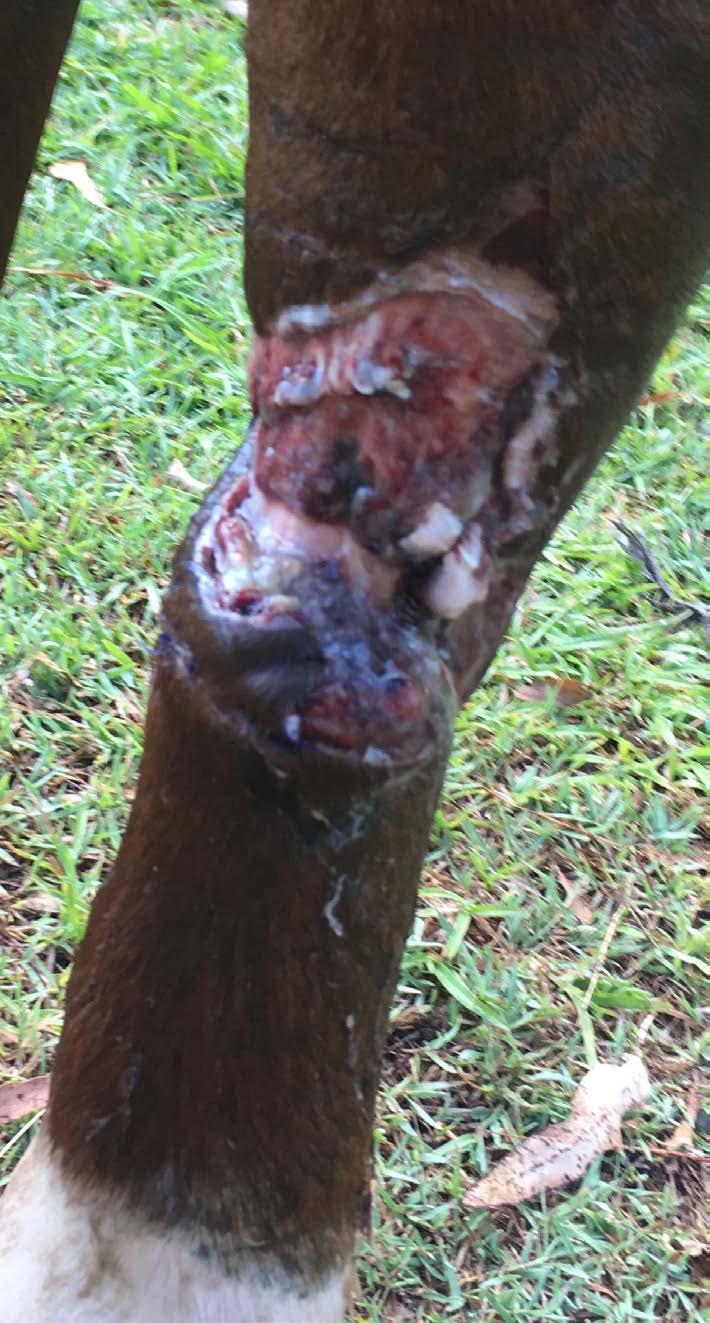
DAY 1 DAY 2 DAY 4
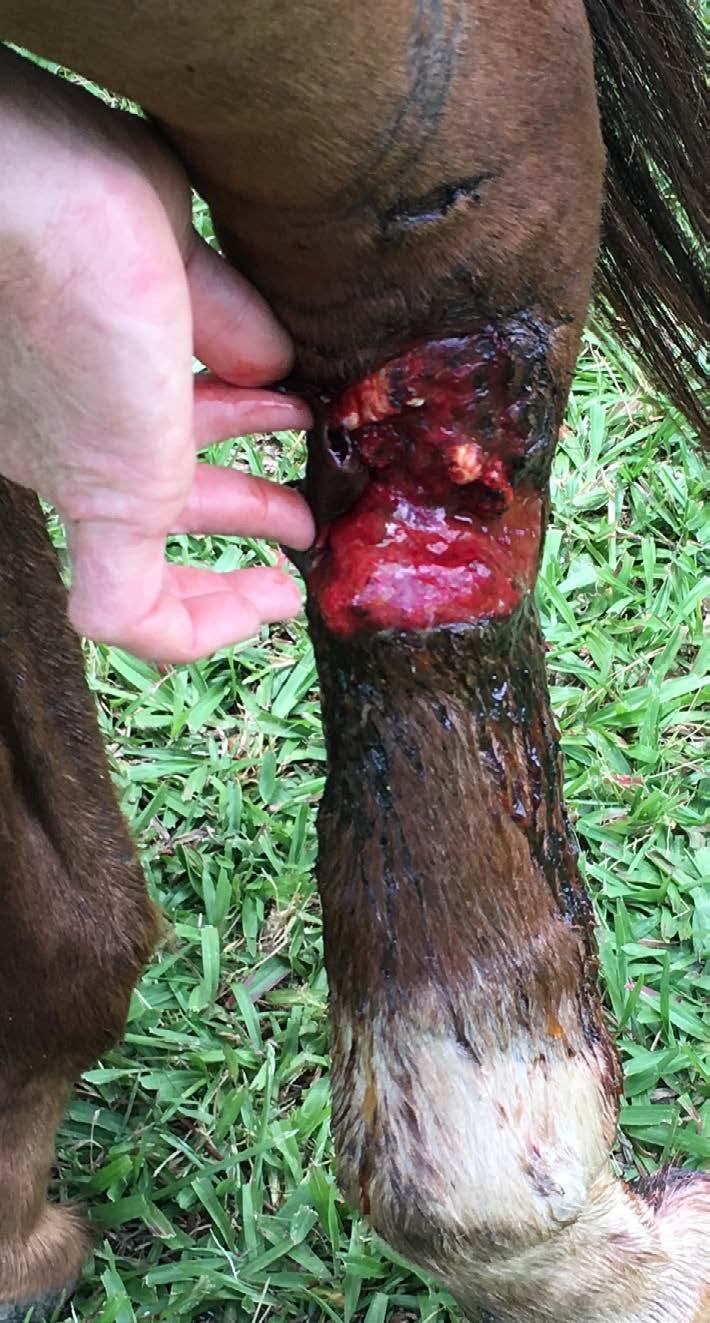
would cost, he said, at least $10,000 with no guarantee that it would work. Without it, however, there was very little, probably zero, chance she would ever be a riding horse again, and she would have some signs of the damage from the injury forever. He said in his honest opinion there was a 70% chance she would pull through, and I would need to understand that – particularly with so much bone showing - there was a chance that an infection could set in.
I looked at my girl, and my heart wept. I couldn’t believe that this was the same horse that only ten days before had sized up the metre-high fence around the yard she was eating in, taken a step back and casually leapt it as if it was 50cms, landing in the garden, and eating as if it was everyday a horse hopped out of a corral. Well, there would be no jumping in her future, that was for sure.
But in the immediate ‘then’, having made the decision that expensive surgery wasn’t an option, was the next best thing – intensive nursing. We had to give her antibiotic injections twice a day for ten days, to prevent any infection to the exposed bone. I was very lucky to have a friend, Siobhan, who had been a huge help with the horses over the previous year, and had also been a vet nurse. She stepped in to help me with the injections so I didn’t have to do them all myself, and another friend, Dawnie, a riding instructor also arrived like an angel from heaven to help.
Looking back on those early days, it felt almost as if I had a new baby – which wasn’t helped by the fact that at exactly the same time as Eva’s injury my daughter had bought a French Bulldog puppy who was having trouble sleeping through the night. So at home I had puppy toilet-training and broken nights, and twice a day I was driving a one-hour round trip to be there with Eva for her injections and bandaging.
The clear order from Richard Gregory, my vet, was manuka honey dressings, as well as the injections, as well as bute to keep her comfortable. We talked about whether to keep her contained, and his advice was that it was much better for her not to be locked up in a small space, she would only fret, he said, and also it would be better for her healing if she could keep moving.
After the initial shock was over I wanted to think about how else I could


DAY 8 DAY 16 DAY 26
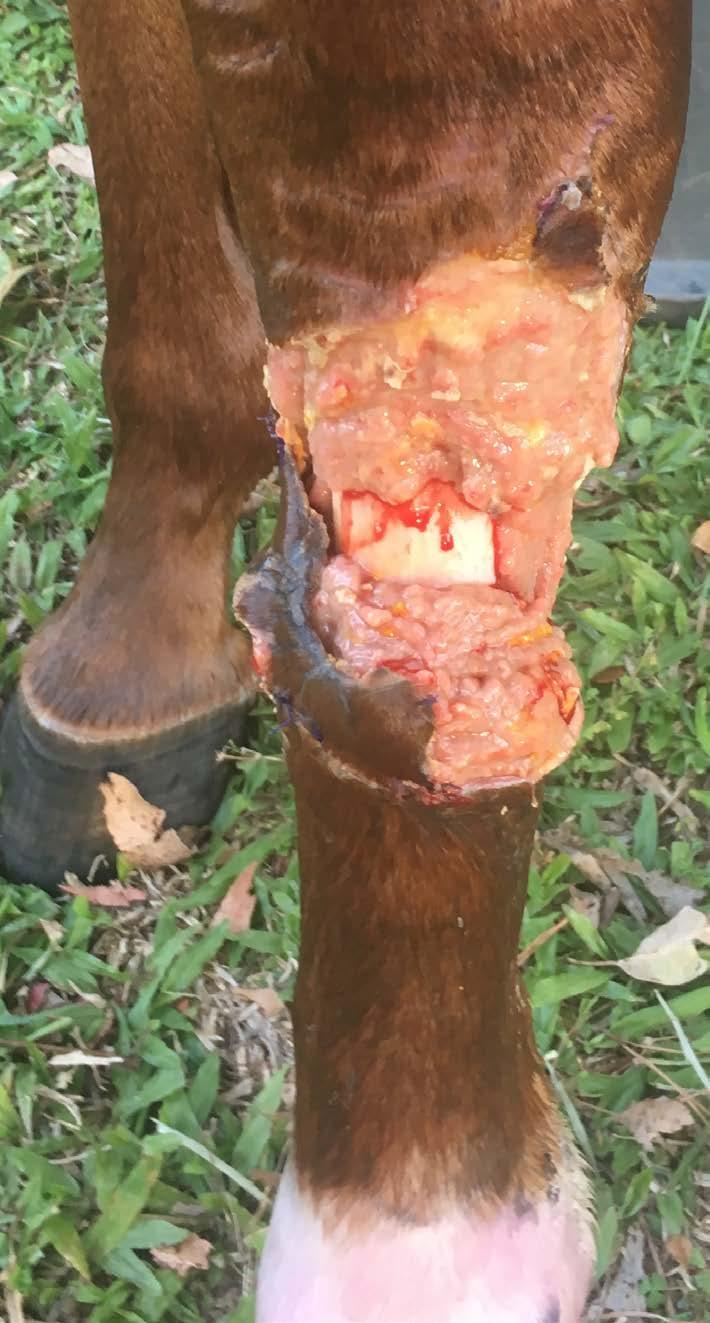
support her. At Equitana I’d bought an EQU Stream Z band for its magnetic resonance healing qualities. I’d actually thought I could use it for my occasional bursts of RSI, but I rang and asked if I could order an extra one, and to get advice as to whether they would be helpful. It was a bit of nothing ventured, nothing gained, but within a few days Eva had two EUQ Stream Z bands on, one on a front leg and one on a back leg. What everybody involved in her healing journey noticed was how quickly the swelling she had went down after the bands had been put on, and given the severity of the injury that in itself was a huge relief.
I also used garlic granules in her food to help her fight infection, and once the antibiotics were over, I gave her a course of probiotics.
Another extremely useful product was something she was already on for her hooves, which are a bit flat and thinnedsoled, which was Andrew Watt’s Hoof Gold. A conversation with Andrew confirmed to keep her on it, no matter what, because the extra minerals in Hoof Gold could do nothing but good.
And so began a nine-month journey. The risk of infection in the bone was real, and so even after the antibiotic injections were over, we had to keep up anti-biotic powder twice a day until there was new flesh over the bone. At first it seemed as if it would never happen, but six weeks after her injury, there was no bone to be seen. At last. Every small milestone seemed like a triumph. I was also extremely lucky that my husband put his metaphoric shoulder to the wheel, and came to help me every time I had to re-do the bandages, because even with feed in front of her, Eva was not keen on the dressing removal, cleaning, hosing, and re-application of honey bandages and dressing.
After a month, a new horse, Aztec, arrived. I was a bit nervous at the idea of introducing her into the equation, but it was yet again to be another lesson from the horses themselves. It was as if Tyra and Eva, who were already showing signs of boredom at this new restricted life, were waiting for Azzie to show-up. I spent a few hours getting them acquainted over the fence, and once I was sure they seemed content, I put Aztec in with the other two. Lo and
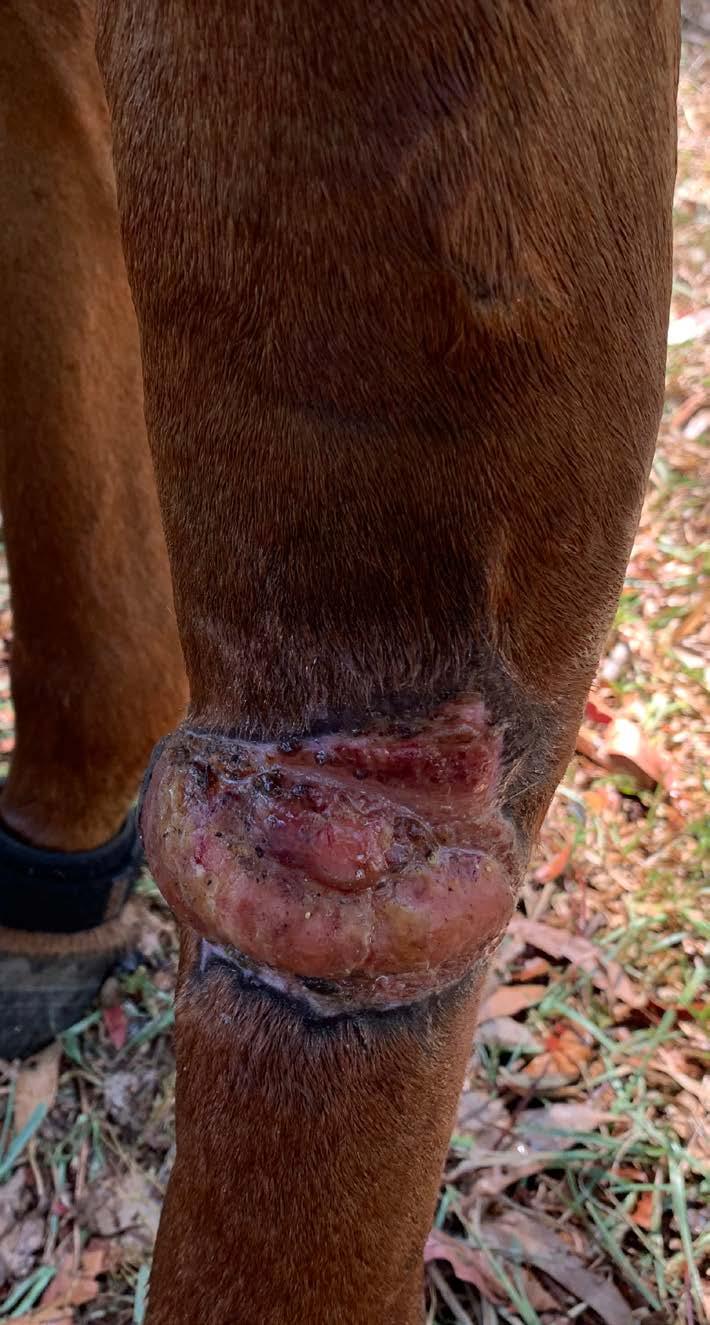
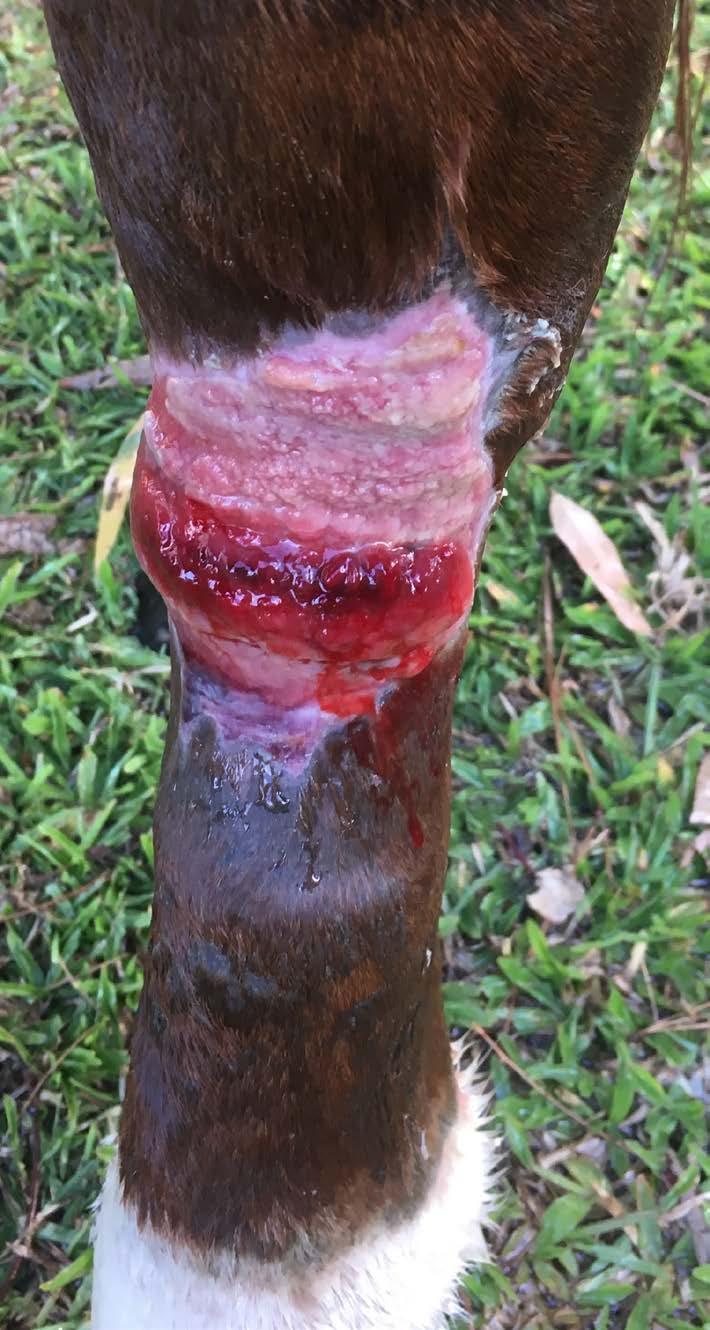
DAY 44 DAY 56 DAY 72
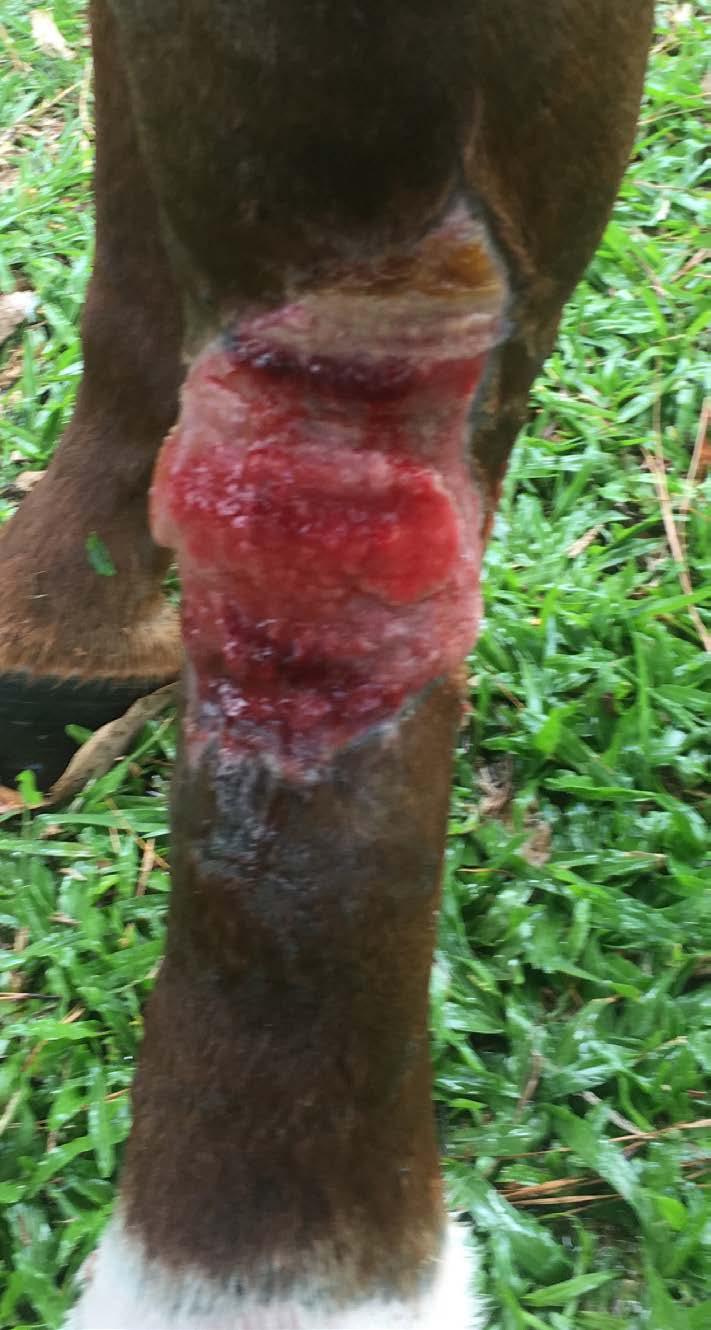
behold, they not only said a gentle hello to each other, they then took her on a guided tour of their ten-acre paddock. I watched from the top of the hill as they went carefully down the hill, around the bamboo stands, along the edge of the creek, through the stands of trees and around the dam.
I’d never witnessed quite such a gentle introduction before, and it continued in this vein with Aztec being one of the few horses I’ve met who managed to make friends instantly with two horses. Suddenly my two friends were the Three Amigos, and much less bored, which can’t have been a bad thing for Eva’s healing. In fact after we treated Eva, which we always did while she was eating to help take her mind off it, Azzie and Tyra would often stand either side of her as if they were comforting her for what was going on.
As the jelly-like substance of new growth increased, and new skin began to gradually form from the top and bottom of the wound, we were able to drop back to manuka honey dressings every second day – and that was a huge relief to both Eva and me!
Then, as the healing started to speed up things went a bit too quickly, and proud flesh began to sprout, the cauliflower like growths protruding from her leg, so Richard came and conducted a Texas Chainsaw massacre of the proud flesh – which didn’t seem to bother Eva one bit, and provided a kookaburra with some particularly grotesque mouthfuls of food. He showed me how to mix a little copper sulphate – bluestone - into a base of sorbolene and the next phase of the healing was to use that when necessary with a dressing to take the proud flesh down. It worked brilliantly, and Eva’s leg began to take on a more normal shape.
After about three months, Richard came to do a check on her and was astounded at her recovery. For a horse who’d severed two tendons, he said, she was little short of miraculous.
He spoke too soon. Only a few days later, I arrived to find that Eva was moon-walking – in the way of a horse who has float boots on. She was lifting the injured leg high up, almost kicking her stomach, and then flailing her hoof around before bringing it down on to the ground. I felt sick. What on earth, I wondered, had happened?
‘She was lifting the injured ‘ leg high up, almost kicking her stomach … I felt sick.
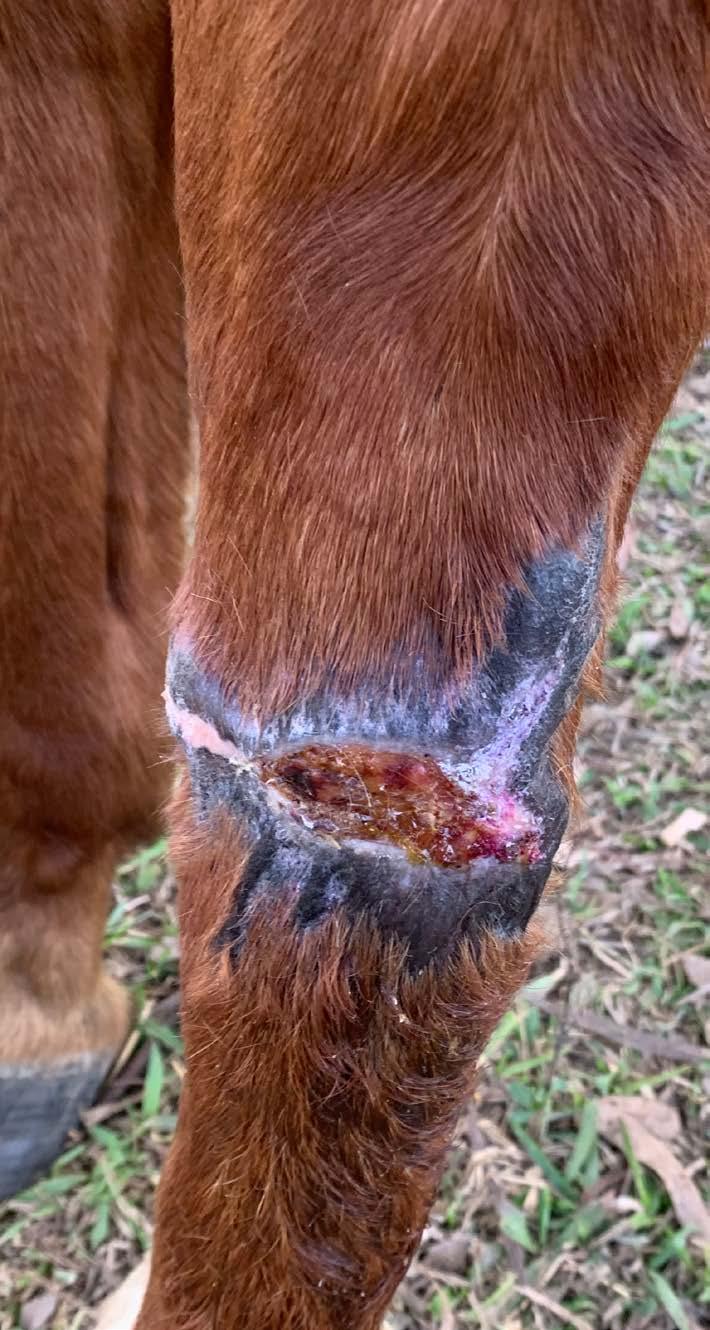
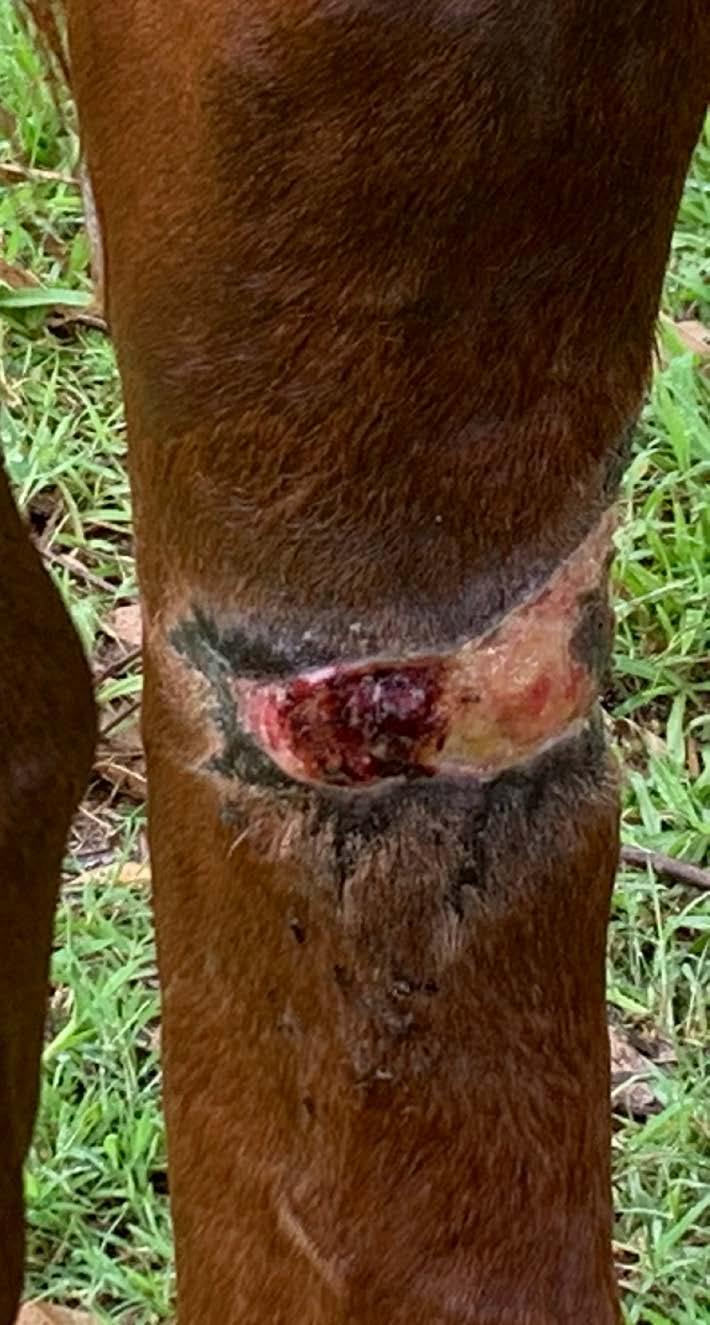
DAY 100 DAY 121 DAY 197
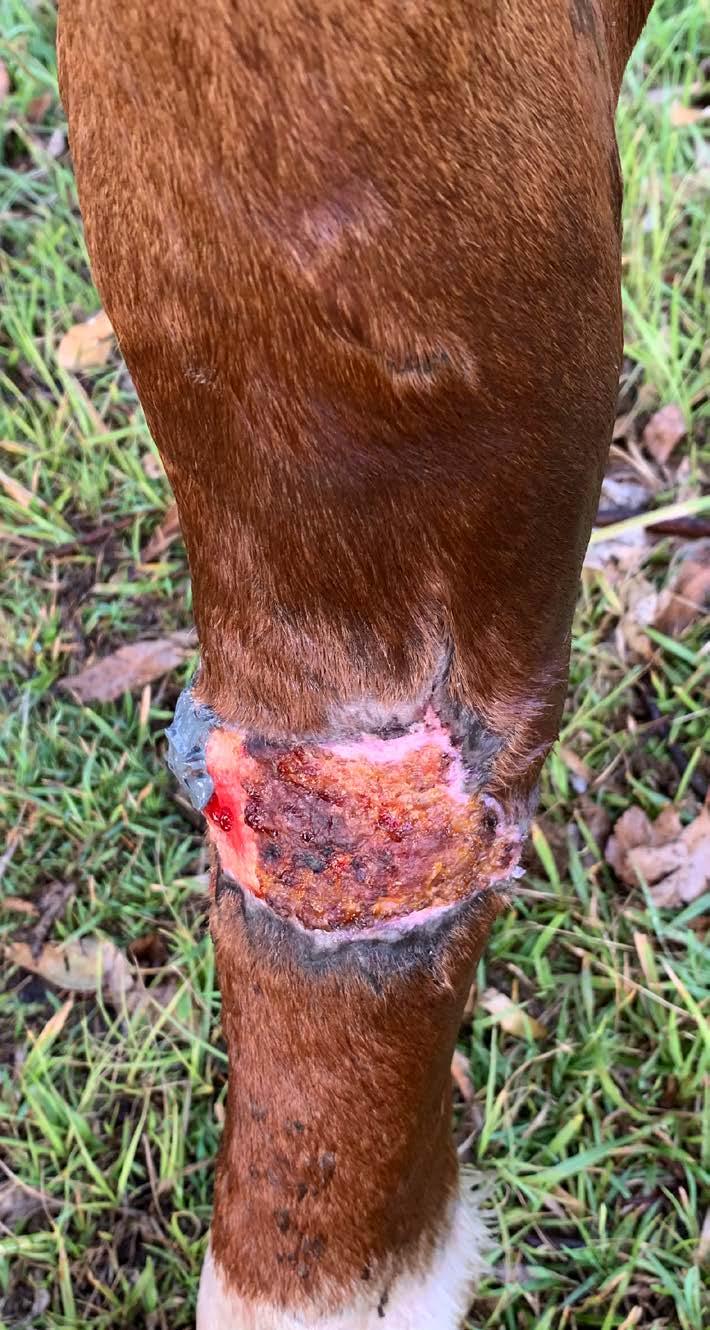
I called on every vet I knew, and even some I didn’t, and sent them video and photos of this sudden, strange new twist. The advice that came back wasn’t heartening. The general consensus was that over a period of time the moonwalking might lessen but it would always be there to a greater or lesser extent, and one vet suggested that it might never improve.
Yet again, I was devastated. If it didn’t improve substantially, it seemed to me very likely I might have to consider putting her to sleep. She was obviously distressed by this strange new turn of events – her hoof dangling in mid-air, searching for solid ground beneath her.
But nothing ventured, nothing gained. I turned to a local acupuncturist, Ben Walder, for help, and to my surprise just one visit from him and the extreme raising of the leg was immediately much less.
The moon-walking stayed for several months, and Eva being Eva, the minute her back-leg seemed to improve to the point where she could use that hoof again as a balancing point, she would canter around my flat ‘work’ paddock, leading the others into a fine old play, with me swearing at her for being quite so stupid. A day of Eva running around would mean a few days of Eva being sore but she didn’t once lose her position as boss of the herd, or change her feisty personality.
Then after a few months, the moonwalking lessened, and gradually disappeared. It was a day of elation for me. If it hadn’t been for the remaining inch of new growth required to fully heal the wound, you might not know anything had ever happened to her, if you didn’t spot the slight floppiness above the back near hoof, around the fetlock.
Through the whole process, and once I knew she was going to survive, I had to do deal with a lot of grief. We’d only just started her riding journey but she was kind and sweet to ride, and when I’d moved Tyra and Eva to another property just for a couple of nights she’d almost galloped onto the float, in her eagerness to get out and about. She enjoyed going for walks up the lane and around the surrounding country roads, and for explorations up to the local showgrounds, and now we could do none of that. In fact, for months, after I’d
‘I’ve learned not to discount Eva’s ability ‘ to heal ... we’ll take the journey together and see.
finished her treatment, she’d hobble up to the gate and look back at me as if to ask if we were going out.
Eva was already doing therapy work with me before the accident, and she is very good at it but for me it was still a heartbreak, it wasn’t the destiny I’d planned for her, and yet, when something of this nature happens we have to adjust to our circumstances.
By now my $1500 Off The Track Thoroughbred had also cost me close to $4000 in vet bills and supplies, but I didn’t regret a single cent of it.
One day Richard arrived to give Sapphire, a new arrival, a Hendra vaccination and the horses, excited to be up in the home paddock for the first time in a few weeks, set off at brisk gallop around the edge, doing laps – Eva leading the pack, only pausing to chuck in the occasional spectacular buck or rear.
“If I hadn’t seen this with my own eyes I wouldn’t have believed it was possible,” Richard told me. He also confessed to me that at the start he wasn’t sure she’d pull through, and that even once she had, he knew of horses that had got so fed up with being treated they had become dangerously aggressive to the point that there was no choice but to put them to sleep, and that he’d been worried that might happen with Eva.
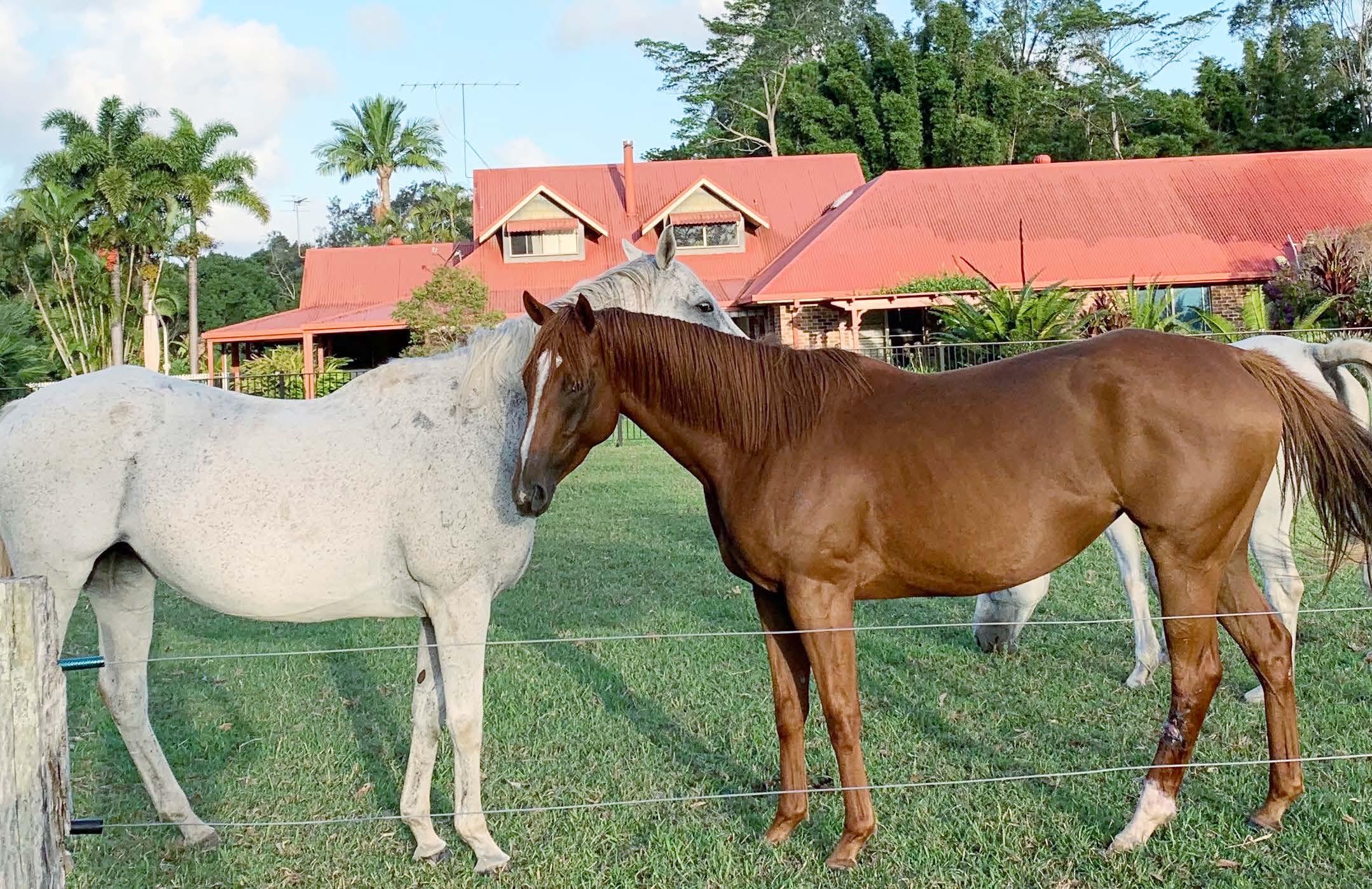
I told him that it had been touch and go the last few weeks of the dressings, but fortunately her obvious distaste at being treated had happened at almost exactly the time when I could finally leave the wound to heal naturally. But even now, eight months later, it’s still an up and down process. There’s a bit less than half an inch left of pink scar which is taking its precious time to heal, and Eva, convinced when she’s feeling well that her leg is completely better, likes nothing more than a gallop up and down the 10acre paddock, which results inevitably in swelling and a sore leg for a few days.
But I don’t blame her. She’s a horse, she lives in the moment. When she feels good, she feels good, when it’s sore, she hobbles a bit and rests it.
The verdict is out on whether she’ll ever be able to be ridden. I’ve been told again, everything from ‘never’, to no reason why not, to – which seems to me to make sense – she might be a walk/trot horse but nothing more. But I’ve learned not to discount Eva’s ability to heal, or to make decisions about what she wants to do, so we’ll take the journey together and see. If it ends up that she’s simply a friend and companion to me and to Tyra, whom she loves dearly, then so be it.
The other day, she got her first walk (being led) up the lane since the accident. She was very bright and sparky, and so happy to be out. She didn’t moon-walk, she walked confidently, and I think both of us breathed a little sigh of relief that life could continue, if not quite as we’d intended, then at least with our best hooves forward.










